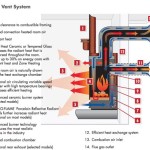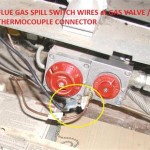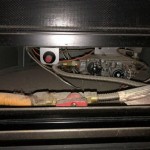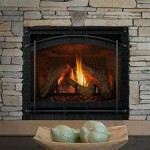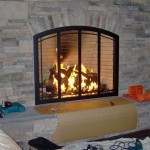Fireplace Insert Reviews: Understanding Your Heating Options
Fireplace inserts represent a significant upgrade for homeowners seeking to enhance the efficiency and aesthetic appeal of their existing fireplaces. These self-contained units are designed to fit directly into an existing fireplace opening, transforming it from a potentially inefficient source of heat loss into a powerful and controllable heat source. Selecting the right fireplace insert requires careful consideration of various factors, including fuel type, heating capacity, efficiency, and features. This article aims to provide a comprehensive overview of these factors and explore the different types of fireplace inserts available, offering a framework for informed decision-making.
Fuel Type: Comparing Wood, Gas, and Electric Inserts
The most fundamental decision when choosing a fireplace insert revolves around the fuel type. The primary options are wood-burning, gas-burning, and electric inserts, each offering distinct advantages and disadvantages.
Wood-burning inserts offer the traditional ambiance of a wood-burning fire, complete with crackling flames and the aroma of burning wood. These inserts typically provide substantial heat output and can be a cost-effective heating option in areas where wood is readily available. However, wood-burning inserts also require regular maintenance, including loading wood, removing ashes, and ensuring proper ventilation. They also produce emissions that require proper venting through a chimney liner. Modern wood-burning inserts are designed to be more efficient and produce fewer emissions than traditional open fireplaces, often meeting EPA standards.
Gas-burning inserts offer convenience and ease of use. They are available in both natural gas and propane models, allowing homeowners to choose the fuel source that is most readily available or cost-effective. Gas inserts can be ignited with the flip of a switch or the push of a button, and many models feature thermostats and remote controls for precise temperature regulation. They also require less maintenance than wood-burning inserts, as there is no need to load fuel or remove ashes. However, gas inserts do require a gas line connection and professional installation and maintenance is recommended. While they produce less particulate matter than wood-burning inserts, they still emit carbon monoxide and require proper venting.
Electric inserts are the most convenient and versatile option. They require no venting and can be installed in almost any room with an electrical outlet. Electric inserts produce heat using electric coils or infrared heaters and often feature realistic flame effects. They are relatively inexpensive to purchase and operate and require minimal maintenance. However, electric inserts typically produce less heat than wood or gas inserts and may not be suitable for heating large spaces. They are best suited for supplemental heating and creating ambiance.
Heating Capacity and Efficiency: Matching an Insert to Your Needs
An important factor in selecting a fireplace insert is its heating capacity, measured in British Thermal Units (BTUs). The appropriate BTU rating will depend on the size of the area you wish to heat, the insulation levels in your home, and the climate in which you live. It is generally advisable to consult with a professional to determine the optimal BTU rating for your specific needs.
Efficiency is another critical consideration. The efficiency rating of a fireplace insert indicates the percentage of fuel that is converted into usable heat. Higher efficiency ratings translate to lower fuel consumption and reduced heating costs. Wood-burning inserts are typically less efficient than gas or electric inserts, but modern EPA-certified models are significantly more efficient than older, non-certified units. Gas inserts often boast high efficiency ratings, while electric inserts are virtually 100% efficient, as all of the electricity consumed is converted into heat. However, it is important to note that the cost of electricity may be higher than the cost of gas or wood in some areas.
When evaluating heating capacity and efficiency, it is also important to consider the differences between steady-state efficiency and overall efficiency. Steady-state efficiency refers to the efficiency of the insert when it is operating at its maximum heat output. Overall efficiency takes into account the efficiency of the insert over a longer period, including start-up and cool-down periods. Overall efficiency is a more accurate measure of the actual energy consumption of the insert.
Installation and Maintenance: Ensuring Safe and Efficient Operation
Proper installation and maintenance are essential for ensuring the safe and efficient operation of a fireplace insert. Wood-burning and gas inserts require professional installation to ensure proper venting and gas line connections. Electric inserts can typically be installed by homeowners, but it is important to follow the manufacturer's instructions carefully.
Wood-burning inserts require regular maintenance, including cleaning the chimney, removing ashes, and inspecting the unit for damage. Chimney cleaning is essential for preventing creosote buildup, which can lead to chimney fires. Ash removal should be performed regularly to prevent the ash from clogging the air inlets and reducing the efficiency of the insert. Regular inspections can help identify potential problems early on, preventing costly repairs down the road.
Gas inserts require less maintenance than wood-burning inserts, but still require periodic inspections by a qualified technician. These inspections should include checking the gas line connections, cleaning the burner assembly, and inspecting the venting system. It is also important to monitor the flame pattern to ensure that the insert is burning efficiently. Any unusual flame patterns should be investigated by a professional.
Electric inserts require minimal maintenance. The primary maintenance task is to clean the unit regularly to remove dust and debris. It is also important to inspect the electrical cord and plug for damage. Any signs of damage should be repaired immediately to prevent electrical hazards.
Beyond these fuel-specific considerations, other important factors influence the choice of a fireplace insert. The aesthetic design is clearly important, as the insert becomes a focal point in the room. Inserts come in a wide variety of styles, from traditional to contemporary, and with a range of finishes and materials. Considerations should be made to match the existing decor of the room and personal preferences. The size and shape of the existing fireplace opening are also critical. The insert must fit snugly within the opening and provide adequate clearances for proper ventilation. Accurate measurements are therefore crucial before making a purchase.
Finally, cost is always a consideration. The initial purchase price of the insert can vary significantly depending on the fuel type, heating capacity, features, and brand. Installation costs also vary, with wood-burning and gas inserts typically requiring more expensive professional installation. Operating costs also need to be factored in, including the cost of fuel, maintenance, and repairs. A thorough cost analysis can help homeowners determine the most cost-effective option over the long term.
The control features are also a key aspect. Many modern inserts come with advanced control options, such as thermostats, remote controls, and programmable timers. These features allow homeowners to precisely regulate the temperature and heating schedule of the insert, maximizing comfort and energy savings. Some inserts even feature smart home integration, allowing them to be controlled remotely via a smartphone or other device. The availability of these control features can significantly enhance the user experience and provide greater control over the heating process. Understanding the available options and how they align with your heating needs and preferences can help you make the best choice for your home.
In addition to these practical considerations, some potential buyers could also think about the environmental impact. Wood-burning inserts, even EPA-certified models, produce emissions that can contribute to air pollution, especially in areas with high concentrations of wood-burning appliances. Gas inserts produce fewer emissions, but still contribute to greenhouse gas emissions. Electric inserts are generally considered to be the most environmentally friendly option, as they produce no direct emissions. However, the environmental impact of electric inserts depends on the source of electricity. If the electricity is generated from renewable sources, such as solar or wind, the environmental impact is minimal. However, if the electricity is generated from fossil fuels, the environmental impact can be significant.
The lifespan of a fireplace insert is another factor to consider. With proper installation and maintenance, wood-burning and gas inserts can last for many years. Electric inserts typically have a shorter lifespan, as the heating elements and other components can wear out over time. To extend the lifespan of a fireplace insert, it is important to follow the manufacturer's instructions for cleaning, maintenance, and operation. Regular inspections can also help identify potential problems early on, preventing costly repairs and extending the lifespan of the unit. A good warranty can also provide peace of mind and protect against unexpected repair costs.
Noise levels can also be a factor for some users. While wood burning inserts typically have no mechanical noise beyond the natural crackling of the fire, gas inserts can sometimes generate a slight humming noise from the gas valve or blower fan. Electric inserts can also produce some noise from the fan-forced heating system. The noise level of an insert is typically measured in decibels (dB). Lower decibel ratings indicate quieter operation. It is advisable to read reviews and listen to demonstrations of different models to get an idea of their noise levels before making a purchase, especially if it's for a frequently used room.
Finally, remember that regulations regarding the installation and use of fireplace inserts can vary depending on local codes and ordinances. It is important to check with your local building department to determine any specific requirements or restrictions that may apply in your area. Some jurisdictions may require permits for the installation of wood-burning or gas inserts, and some may have restrictions on the types of fuel that can be burned. Failing to comply with local regulations can result in fines or other penalties.

Kingsman Clean View Gas Fireplace Insert Review Fireplaces Direct Learning Center

Reviews For Dynasty Fireplaces 35 In Led Electric Fireplace Insert Black Matt Pg 1 The Home Depot

5 Best Electric Fireplace Inserts According To Reviews Modern Blaze
.aspx?strip=all)
Top 11 Gas Fireplace Insert Trends Of 2024

Reviews For Valuxhome 23 In Electric Fireplace Insert With Overheating Protection 750 Watt 1500 Black Pg 1 The Home Depot

Reviews For Valuxhome 36 In 750 1500 Watt Black Electric Fireplace Insert With Thin Trim Adjustable Flame 3 Color Top Light Pg 1 The Home Depot

Reviews For Valuxhome 23 In Electric Fireplace Insert With Overheating Protection 750 Watt 1500 Black Pg 1 The Home Depot

10 Best Electric Fireplace Inserts Of 2024 Tested And Reviewed

Best Wood Burning Fireplace Insert Reviews Top 10 2024 Inserts

Why Should I Switch From A Wood Burning Fireplace To Gas
Related Posts

